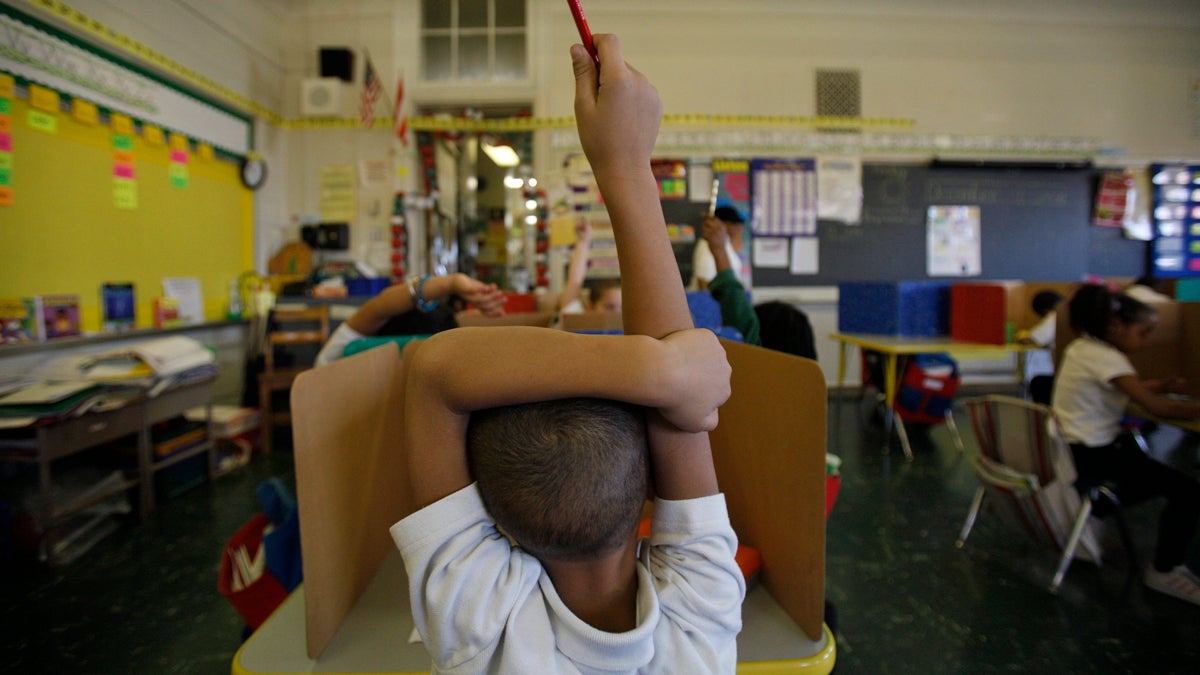Hold harmless: funding protection or red herring?
Listen
A student raises his hand at Isaac Sheppard School in Philadelphia. (Photograph by Jessica Kourkounis)
“Hold Harmless” protects funding for some school districts, and means less funding for other districts in need.
Seventh in an occasional series of podcasts and web “explainers.” To listen to the podcast, click the audio player above.
What does “hold harmless” mean?
It’s a policy underlying the distribution of state education aid in Pennsylvania. “Hold harmless” provides that no district will get less money in the new funding year than it got in the previous year.
What’s the effect?
It means school districts that lose enrollment do not lose state aid as a result. Do the basic arithmetic and you realize that this results in such districts getting more aid per student than before.
So, in a sense, “hold harmless” works for a city like Pittsburgh, where enrollment is down about 12 percent over the last five years and nearly 60 percent from its peak. As a result, Pittsburgh’s per-student spending is around $20,000, well above those figures for other cities such as Philadelphia ($12,570).
“Hold harmless” is sort of good for affluent suburban districts, which may not get a lot of state aid but are guaranteed by another state rule to always get some. “Hold harmless” guarantees that their allotment will never shrink, no matter how tough the overall state education budget gets and how far state aid falls short of what less affluent districts might need.
So who objects to “hold harmless”?
The policy annoys growing school districts in formerly rural areas such as the Poconos, because in a time of limited school resources, their state aid tends not to keep pace with their growth.
It also annoys urban school districts with more stable enrollment, which struggle to pay the higher costs that come with urban education and which notice that a Pittsburgh loses no state aid even though it’s losing students.
But Donna Cooper, executive director of Public Citizens for Children and Youth, an advocacy group, calls the “hold harmless” issue a red herring.
The real issue, she says, is that overall state funding for local schools is inadequate.
“People go, ‘Oh, they’re spending money on kids they don’t have,” she said, arguing that contrary to that, “hold harmless” helps some districts get a little closer to what she would consider adequate per pupil funding. “If you got rid of hold harmless, half the districts would lose money.”
Will “hold harmless” go away anytime soon?
The last number cited by Cooper helps explain why “hold harmless” is such a durable policy. Even while some districts attack the policy as unfair, almost every state lawmaker has a school system in his or her district that benefits from it.
That makes it hard to get enough votes in the General Assembly to get rid of the rule, unless and until the governor and General Assembly could agree to an infusion of cash into the aid pool that would lift all boats.
In the Multiple Choices podcast, Keystone Crossroads senior education writer Kevin McCorry joins with Paul Socolar, publisher and editor of the Public School Notebook, and Notebook contributing editor Dale Mezzacappa to explain and explore the history, complexities and controversies of public education funding in Pennsylvania.
Look for new installments of Multiple Choices every week for the rest of the spring, as the General Assembly reviews Gov. Wolf’s ambitious school funding and tax plan.
WHYY is your source for fact-based, in-depth journalism and information. As a nonprofit organization, we rely on financial support from readers like you. Please give today.




